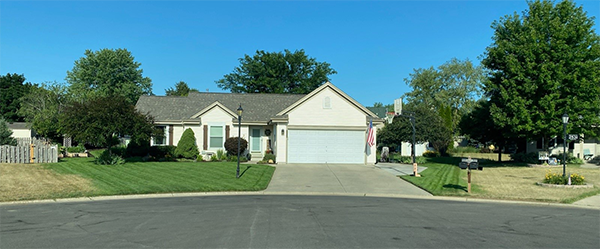When the rain slows down and the heat kicks in, your lawn starts working overtime to survive. You may not notice the signs of stress right away—but your grass does. Understanding how drought affects your lawn and responding early can make all the difference between a yard that recovers and one that doesn’t.

What Does Drought Stress Look Like?
Your lawn won’t turn brown overnight, but the signs start small—and by the time they’re obvious, the damage has often set in.
Watch for These Early Warning Signs:
- Color shift from deep green to a dull bluish-gray
- Footprints remain visible long after walking across the lawn
- Grass blades curl or fold to conserve moisture
- Dry, brittle feel underfoot
- Patchy or uneven growth, especially in sunny or sloped areas
If you see these signs, your lawn is telling you it’s in survival mode—and it’s time to act.
How to Water Right in Drought Conditions
Most lawn issues during drought stem from how we water, not just how often.
Watering Tips:
- Water deeply—Aim for 20–30 minutes per area (about 1 to 1.5 inches per week total).
- Water every 2–3 days, not daily. Frequent light watering encourages shallow roots and weakens the turf.
- Water early in the morning, ideally between 6–10 a.m., when evaporation is low.
- Avoid watering in the evening—wet grass overnight creates ideal conditions for fungus and disease.
Consistent deep watering builds deeper, stronger roots that can access water reserves during dry spells.
How Lawn Doctor Helps

While we can’t make it rain, we can help your lawn make the most of every drop. Our team uses specialized treatments designed to:
- Hydra-Guard: Our secret weapon for drought defense. It helps your lawn retain moisture longer, stay greener during dry spells, and bounce back faster from stress. Whether you’re preparing for heat or trying to recover quickly from dry conditions, Hydra-Guard is a powerful tool in the plan.
- Improve moisture retention
- Reduce drought-related stress
- Encourage root depth and density
This proactive care gives your lawn an edge when the weather turns dry.
Don’t Wait Until It’s Brown
Once drought damage sets in, it takes more time, water, and effort to recover. By responding early—and watering smart—you can keep your lawn thriving through the dry spells.
Have questions about watering or stress signs in your lawn? We’re here to help.
330-810-9749

